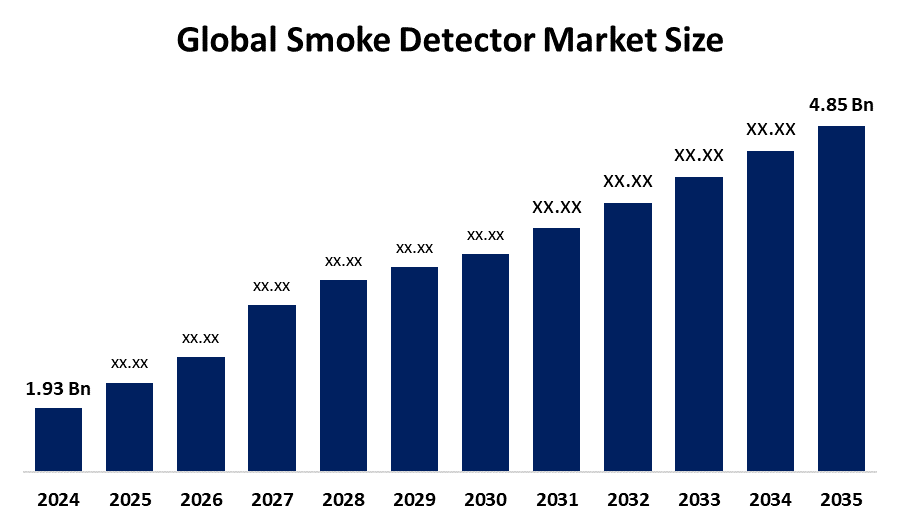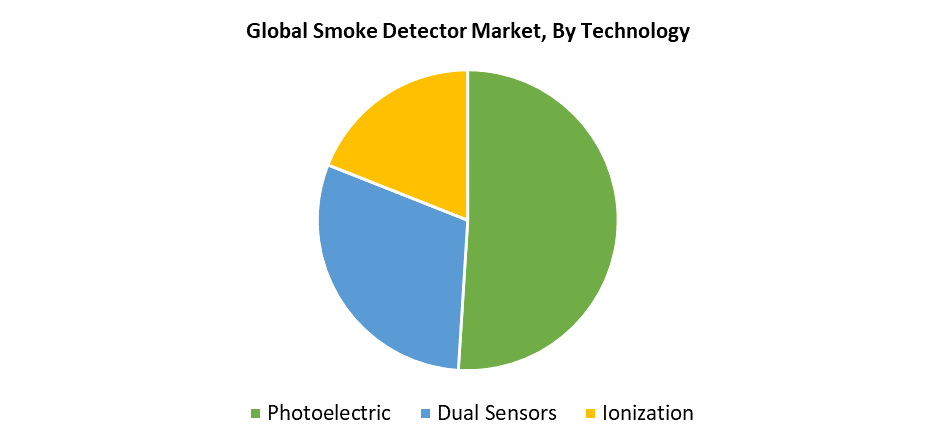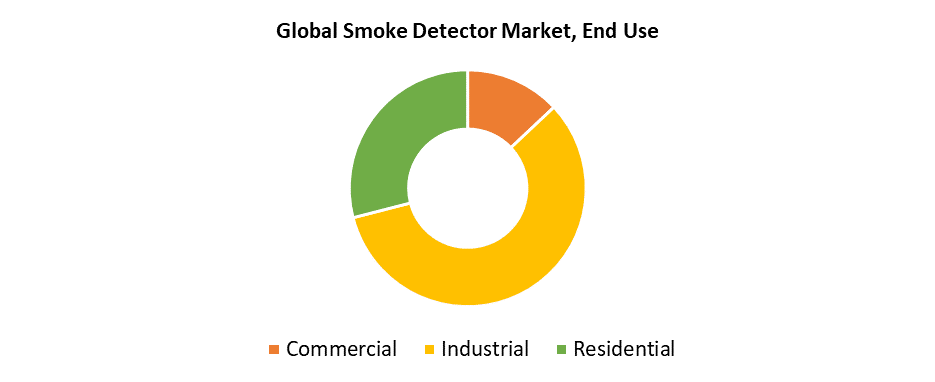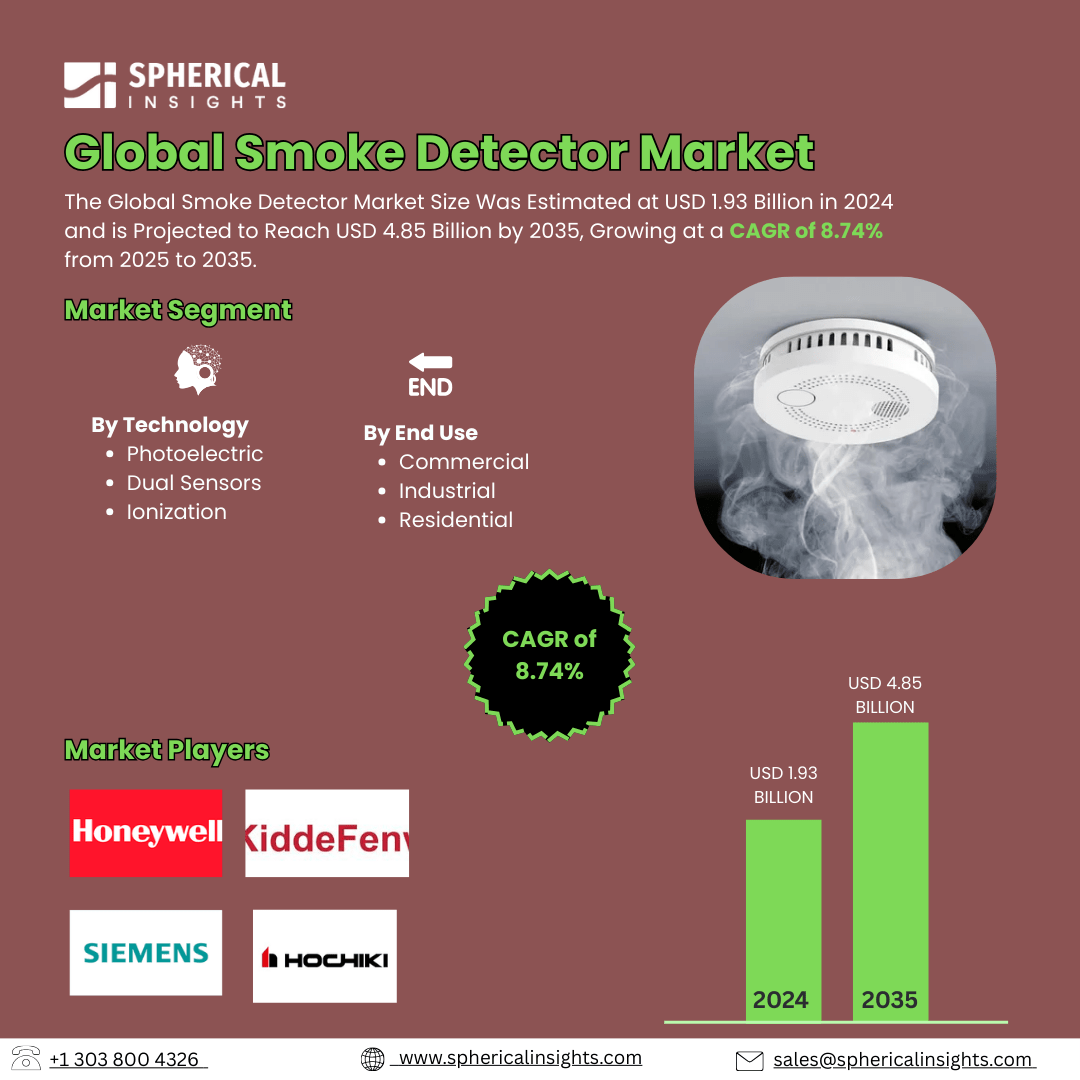Smoke Detector Market Summary
The Global Smoke Detector Market Size Was Estimated at USD 1.93 Billion in 2024 and is Projected to Reach USD 4.85 Billion by 2035, Growing at a CAGR of 8.74% from 2025 to 2035. The market for smoke detectors is expanding due to rising fire safety laws, increased public awareness of fire safety, and technological developments in detection systems.
Key Regional and Segment-Wise Insights
- In 2024, North America held the largest revenue share of over 29.5% and dominated the market globally.
- In 2024, the photoelectric segment had the highest market share by technology, accounting for 51.3%.
- In 2024, the industrial segment had the biggest market share by end use.
Global Market Forecast and Revenue Outlook
- 2024 Market Size: USD 1.93 Billion
- 2035 Projected Market Size: USD 4.85 Billion
- CAGR (2025-2035): 8.74%
- North America: Largest market in 2024

The smoke detector industry functions globally to develop, distribute, and sell smoke detection equipment for commercial, industrial, and residential fire prevention applications. The fast-paced expansion of the construction industry, along with mandatory fire detection system requirements in new buildings, drives the smoke detector market growth. Worldwide governments execute fire fatality reduction policies through their smoke detector installation requirements in residential and commercial structures. The combination of artificial intelligence with the Internet of Things has revolutionized smoke detection systems through technological progress. Consumers who understand technology find smart detectors appealing because these products now deliver immediate alerts along with distant monitoring capabilities and improved dependability. The fast-paced growth of smart houses, together with increasing public knowledge about fire safety, causes faster market adoption of smoke detectors. The market experiences increased expansion because insurance companies provide incentives to properties that have certified safety detection systems installed.
The quick urban development and infrastructure growth in emerging nations, including China and India, demand advanced fire prevention systems. Higher disposable incomes together with improved living standards motivate homeowners and business owners in these regions to invest in reliable smoke detectors. The hotel industry elevates its detection system demand through its strict safety regulations, which drive continuous adoption of modern detection technology. Smart cities' expanding popularity drives the implementation of integrated fire safety networks. Manufacturers address high installation and upgrade expenses through affordable retrofitting solutions they provide to their customers. The market will experience growth because of these budget-friendly and easy-to-install solutions, which appeal to small businesses and cost-conscious consumers seeking to update their fire safety systems.
Technology Insights

The photoelectric smoke detector segment led the market in 2024 by generating 51.3% revenue because it detects slow-burning fires, which occur in residential and commercial environments. These detectors use a laser beam together with sensors to detect smoke particles, thus providing exact detection for fires that start from electrical faults or unattended cigarettes. Their design reduces false alarms caused by cooking or humidity, thus enhancing their dependability. The worldwide adoption of these detectors has accelerated because of both increased fire safety awareness and new governmental regulations. Modern customers prefer photoelectric models primarily because manufacturers have introduced wireless technology together with smart home system compatibility. The market maintains its expansion through both new installation projects and retrofit work because consumers choose dependable solutions for their safety needs.
The dual sensor segment is anticipated to experience the highest CAGR of 7.5% during the forecast period because it provides complete fire protection solutions. Dual sensor detectors maximize safety effectiveness by uniting photoelectric and ionization technologies to detect both rapid flames and gradual smoke fires. Customers feel more confident about fire detection systems because they combine both sensor capabilities, which reduces false alerts. The rising adoption of smart home technologies and their connection to home automation platforms make dual sensor devices increasingly popular among consumers. The residential market shows increasing interest in wireless integrated smoke and carbon monoxide (CO) detectors as new technological advancements emerge. The demand for dependable multipurpose smoke detection systems continues to increase because modern infrastructure and smart cities elevate safety standards.
End Use Insights

The industrial segment dominated the smoke detector market in 2024 because government laws enforce strict fire safety standards for high-risk manufacturing plants, chemical factories, and oil and gas facilities. These situations require advanced smoke detection systems because they present expensive damage risks alongside worker safety concerns. The increasing adoption of automation alongside smart technology in industrial operations has accelerated the deployment of advanced detectors, which offer real-time monitoring capabilities and fast alarm responses. The solutions implemented reduce both operational downtime and enhance safety measures. The industrial sector requires modernized smoke detectors because enterprises are investing in system modernization to comply with evolving safety regulations.
The residential segment will experience the fastest growth rate throughout the forecast period because homeowners are becoming more aware of fire safety with rising adoption of smart home technologies. Modern smoke detectors have become popular among consumers because these devices detect fires early, thus reducing property damage and preventing loss. These systems attract users through their smart home integration benefits, which enable instant alerts and remote device control and automated operations with other connected equipment. The rising population density, together with expanding residential construction in developing economies, fuels increased market demand. The market for residential safety is expected to expand substantially because consumers want connected homes that provide safety and convenience, thus leading to increased installation of smart safety features in new homes and more retrofit projects.
Regional Insights
North America led the worldwide smoke detector market in 2024 by achieving a 29.5% revenue share because of strict fire safety regulations in the US and Canada. The established regulations enforce complete market coverage through mandatory smoke detector installations across all types of buildings, including residential, commercial, and industrial structures. People in the area show heightened awareness about fire-related issues because of frequent fire incidents, which drives them to invest in advanced detection systems. The rising concerns about carbon monoxide (CO) risks push the need for combined smoke detectors with CO detection capabilities. The market expansion occurs due to major industry players operating in the region along with increasing commercial building development. North America maintains its leading market position because residents adopt advanced networked smoke detectors, which receive strong support from the growing smart home market in the region.
Asia Pacific Smoke Detector Market Trends
In 2024, the Asia Pacific smoke detector market emerged as a profitable region due to the quick urbanization and industrialization of China, India, and Japan. The necessity for advanced fire protection solutions such as smoke detectors arises from the growth of residential and commercial construction. The market adoption of smoke detectors accelerates because of governmental rules that demand their installation in all new residential structures, including those in China. The China Fire Protection Association's statistics about rising city fires create an increased need for reliable detection systems. The growing middle-class population presents an opportunity for important companies, including Xiaomi and Honeywell, to sell intelligent smoke detectors at affordable prices. The rising real estate market, particularly in tall buildings, drives continuous market growth since it promotes strict fire safety regulation compliance.
Europe Smoke Detector Market Trends
The smoke detector market across Europe will grow at a 7.5% CAGR throughout the forecast period because of strict fire safety regulations in Germany, as well as the United Kingdom, France, and Sweden. These regulations, which mandate smoke detectors in all public, commercial, and residential spaces, dramatically increase market adoption. People now recognize the importance of advanced fire detection systems because fire incidents occur more frequently. The growing demand for smoke detectors receives additional support from rising residential construction activities, which primarily take place in Sweden and Germany. The market adoption of advanced technologies in smoke detectors includes smart home systems and networked alarm systems, which continue to increase in popularity. The leading companies Honeywell and Bosch are currently dedicating extensive resources to develop new user-friendly products through their research and development efforts. Market expansion receives a boost from changing regulations and heightened consumer safety awareness.
Key Smoke Detector Companies:
The following are the leading companies in the smoke detector market. These companies collectively hold the largest market share and dictate industry trends.
- Honeywell International
- Kidde Fire Safety (United Technologies Corporation)
- Siemens AG
- Hochiki Corporation
- Mircom Group
- Robert Bosch GmbH
- TycoFIS (Tyco International Ltd)
- Johnson Controls International PLC
- ABB Group
- Nittan Co., Ltd.
- Others
Recent Developments
- In September 2024, Edwards announced the launch of their signature Optica smoke detectors in India, along with the local production of these devices. The company wants to cut lead times and improve operational efficiency by utilizing local expertise and infrastructure.
- In August 2023, Hikvision India expanded its safety equipment product line through the launch of independent smoke and gas detection devices for residential and commercial use.
Market Segment
This study forecasts revenue at global, regional, and country levels from 2020 to 2035. Spherical Insights has segmented the smoke detector market based on the below-mentioned segments:
Global Smoke Detector Market, By Technology
- Photoelectric
- Dual Sensors
- Ionization
Global Smoke Detector Market, By End Use
- Commercial
- Industrial
- Residential
Global Smoke Detector Market, By Regional Analysis
- North America
- Europe
- Germany
- UK
- France
- Italy
- Spain
- Russia
- Rest of Europe
- Asia Pacific
- China
- Japan
- India
- South Korea
- Australia
- Rest of Asia Pacific
- South America
- Brazil
- Argentina
- Rest of South America
- Middle East & Africa
- UAE
- Saudi Arabia
- Qatar
- South Africa
- Rest of the Middle East & Africa






